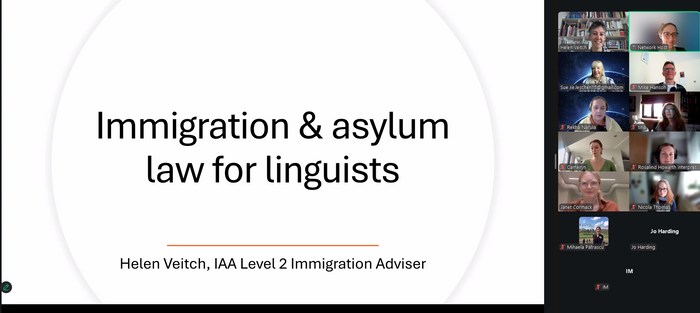LIFT Immigration and Asylum Law Event October 2025
In October, the Law, Insurance and Finance (LIFT) Network held a webinar on “Immigration and asylum law and practice for linguists”.
Helen Veitch, a Japanese to English translator specialising in immigration law who now works as an IAA Level 2 immigration adviser, started by sharing her experiences of working on complex applications with Voices in Exile, a charity supporting vulnerable and destitute migrants.
She explored the legal framework for British citizenship under the British Nationality Act 1981 which is complex and depends on place of birth and parental citizenship/settlement.

International protection routes were then considered, notably under the UN Refugee Convention. If an asylum claim is successful, refugee status can be granted for five years, after which settled status can be sought. Other UK resettlement schemes such as for Afghans and Syrians and “pseudo-protection” for persons from Hong Kong and Ukraine have not always offered refugee status and have sometimes led to uncertainty and family separation.
The Immigration Act 1971 covers immigration controls: entry clearance (visas), leave to enter and indefinite leave to remain (which can be revoked) or settlement. Helen emphasised that much of the detail is contained in the government’s immigration rules which are not legislation but rather a statement policy that can be changed at short notice, as when the family reunion route was abolished in September 2025.
Finally, we considered a case study applying the law and rules to a British/German couple who had married and had a child in Japan and then returned to the UK.
Sue Leschen FITI, an experienced lawyer-linguist, then spoke about her experience as an interpreter in asylum cases. She showed how cultural differences can affect terminology used. For example, the same vessel may be referred to as a “small boat” by the UK media, “dinghy” by the coastguard, “inflatable” by smugglers or indeed a “large boat” by a migrant.
Sue talked about the difficulties arising when it is assumed that interpreters will act as cultural brokers at an interpreting venue. Whilst interpreters may know more than caseworkers due to their on-the-job experience and so find themselves being leaned on, they rarely have formal cultural training. The NRPSI Code of Conduct states that competence includes a level of relevant cultural and political awareness of the countries concerned but that practitioners should not intervene except to alert the parties to a possible missed cultural reference/inference.
A judge may request clarification from an interpreter during a hearing, or an interpreter may spontaneously decide to elaborate when they notice that a cultural issue has been misunderstood. This can be a legal minefield for the unwary. The opposing party may gain helpful new information or an interpreter may give inaccurate information. Therefore, where an interpreter feels that a cultural issue needs clarification, they should seek the judge’s permission to ask the asylum seeker to explain it.
With thanks to both speakers for an informative and thought-provoking presentation which gave a real insight into their work in this area.
